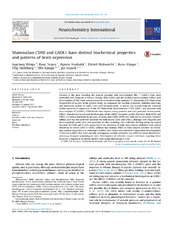| dc.contributor.author | Winge, Ingeborg | en_US |
| dc.contributor.author | Teigen, Knut | en_US |
| dc.contributor.author | Fossbakk, Agnete | en_US |
| dc.contributor.author | Mahootchi, Elaheh | en_US |
| dc.contributor.author | Kleppe, Rune | en_US |
| dc.contributor.author | Sköldberg, Filip | en_US |
| dc.contributor.author | Kämpe, Olle | en_US |
| dc.contributor.author | Haavik, Jan | en_US |
| dc.date.accessioned | 2016-03-22T11:00:57Z | |
| dc.date.available | 2016-03-22T11:00:57Z | |
| dc.date.issued | 2015-11 | |
| dc.Published | Neurochemistry International 2015, 90:173-184 | eng |
| dc.identifier.issn | 0197-0186 | |
| dc.identifier.uri | https://hdl.handle.net/1956/11730 | |
| dc.description.abstract | Variants in the gene encoding the enzyme glutamic acid decarboxylase like 1 (GADL1) have been associated with response to lithium therapy. Both GADL1 and the related enzyme cysteine sulfinic acid decarboxylase (CSAD) have been proposed to be involved in the pyridoxal-5′-phosphate (PLP)-dependent biosynthesis of taurine. In the present study, we compared the catalytic properties, inhibitor sensitivity and expression profiles of GADL1 and CSAD in brain tissue. In mouse and human brain we observed distinct patterns of expression of the PLP-dependent decarboxylases CSAD, GADL1 and glutamic acid decarboxylase 67 (GAD67). CSAD levels were highest during prenatal and early postnatal development; GADL1 peaked early in prenatal development, while GAD67 increased rapidly after birth. Both CSAD and GADL1 are being expressed in neurons, whereas only CSAD mRNA was detected in astrocytes. Cysteine sulfinic acid was the preferred substrate for both mouse CSAD and GADL1, although both enzymes also decarboxylated cysteic acid and aspartate. In silico screening and molecular docking using the crystal structure of CSAD and in vitro assays led to the discovery of eight new enzyme inhibitors with partial selectivity for either CSAD or GADL1. Lithium had minimal effect on their enzyme activities. In conclusion, taurine biosynthesis in vertebrates involves two structurally related PLP-dependent decarboxylases (CSAD and GADL1) that have partially overlapping catalytic properties but different tissue distribution, indicating divergent physiological roles. Development of selective enzyme inhibitors targeting these enzymes is important to further dissect their (patho)physiological roles. | en_US |
| dc.language.iso | eng | eng |
| dc.publisher | Elsevier | eng |
| dc.rights | Attribution CC BY | eng |
| dc.rights.uri | http://creativecommons.org/licenses/by/4.0/ | eng |
| dc.subject | Taurine | eng |
| dc.subject | Cysteine sulfinic acid decarboxylase | eng |
| dc.subject | Aspartate | eng |
| dc.subject | Brain | eng |
| dc.subject | Pyridoxal-phosphate | eng |
| dc.subject | Lithium | eng |
| dc.title | Mammalian CSAD and GADL1 have distinct biochemical properties and patterns of brain expression | en_US |
| dc.type | Peer reviewed | |
| dc.type | Journal article | |
| dc.date.updated | 2016-02-04T13:45:34Z | |
| dc.description.version | publishedVersion | en_US |
| dc.rights.holder | Copyright 2015 The Authors | |
| dc.identifier.doi | https://doi.org/10.1016/j.neuint.2015.08.013 | |
| dc.identifier.cristin | 1315643 | |
| dc.identifier.citation | Neurochemistry International 2015, 90, 173-184. | |

